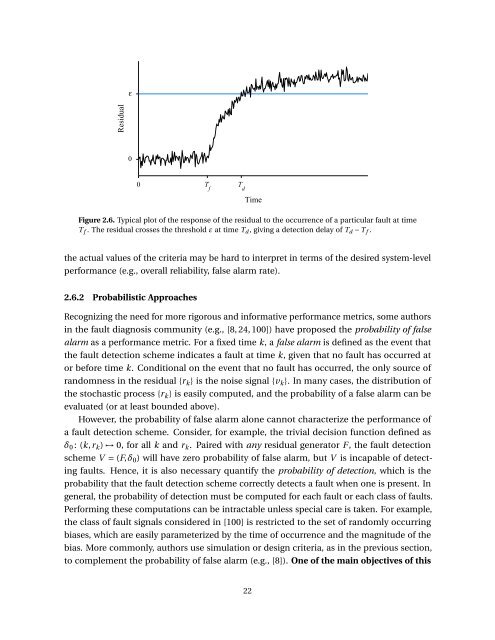Probabilistic Performance Analysis of Fault Diagnosis Schemes
Probabilistic Performance Analysis of Fault Diagnosis Schemes
Probabilistic Performance Analysis of Fault Diagnosis Schemes
You also want an ePaper? Increase the reach of your titles
YUMPU automatically turns print PDFs into web optimized ePapers that Google loves.
ε<br />
Residual<br />
0<br />
0 T f<br />
T d<br />
Time<br />
Figure 2.6. Typical plot <strong>of</strong> the response <strong>of</strong> the residual to the occurrence <strong>of</strong> a particular fault at time<br />
T f . The residual crosses the threshold ε at time T d , giving a detection delay <strong>of</strong> T d − T f .<br />
the actual values <strong>of</strong> the criteria may be hard to interpret in terms <strong>of</strong> the desired system-level<br />
performance (e.g., overall reliability, false alarm rate).<br />
2.6.2 <strong>Probabilistic</strong> Approaches<br />
Recognizing the need for more rigorous and informative performance metrics, some authors<br />
in the fault diagnosis community (e.g., [8, 24, 100]) have proposed the probability <strong>of</strong> false<br />
alarm as a performance metric. For a fixed time k, a false alarm is defined as the event that<br />
the fault detection scheme indicates a fault at time k, given that no fault has occurred at<br />
or before time k. Conditional on the event that no fault has occurred, the only source <strong>of</strong><br />
randomness in the residual {r k } is the noise signal {v k }. In many cases, the distribution <strong>of</strong><br />
the stochastic process {r k } is easily computed, and the probability <strong>of</strong> a false alarm can be<br />
evaluated (or at least bounded above).<br />
However, the probability <strong>of</strong> false alarm alone cannot characterize the performance <strong>of</strong><br />
a fault detection scheme. Consider, for example, the trivial decision function defined as<br />
δ 0 : (k,r k ) → 0, for all k and r k . Paired with any residual generator F , the fault detection<br />
scheme V = (F,δ 0 ) will have zero probability <strong>of</strong> false alarm, but V is incapable <strong>of</strong> detecting<br />
faults. Hence, it is also necessary quantify the probability <strong>of</strong> detection, which is the<br />
probability that the fault detection scheme correctly detects a fault when one is present. In<br />
general, the probability <strong>of</strong> detection must be computed for each fault or each class <strong>of</strong> faults.<br />
Performing these computations can be intractable unless special care is taken. For example,<br />
the class <strong>of</strong> fault signals considered in [100] is restricted to the set <strong>of</strong> randomly occurring<br />
biases, which are easily parameterized by the time <strong>of</strong> occurrence and the magnitude <strong>of</strong> the<br />
bias. More commonly, authors use simulation or design criteria, as in the previous section,<br />
to complement the probability <strong>of</strong> false alarm (e.g., [8]). One <strong>of</strong> the main objectives <strong>of</strong> this<br />
22













